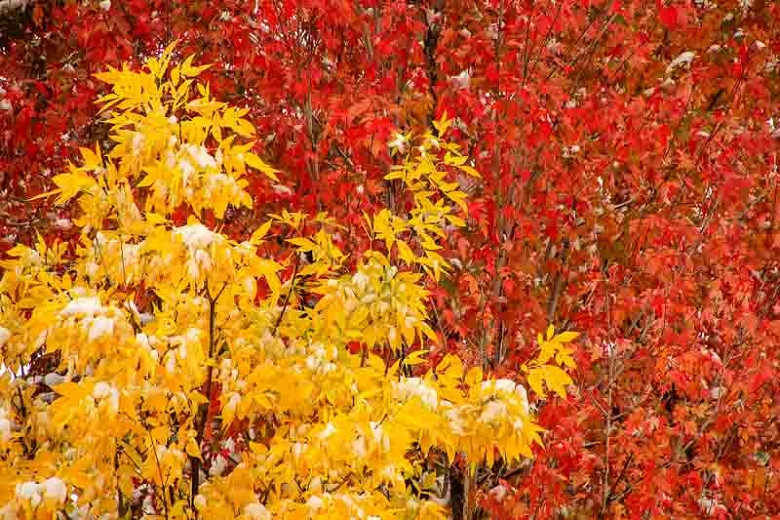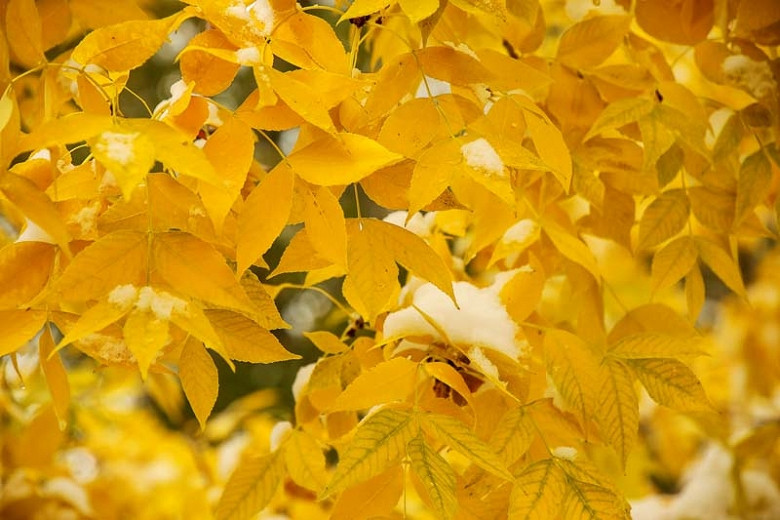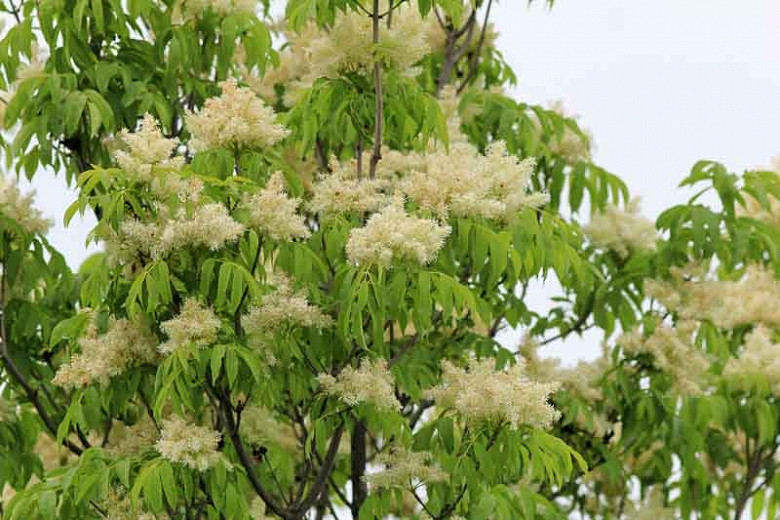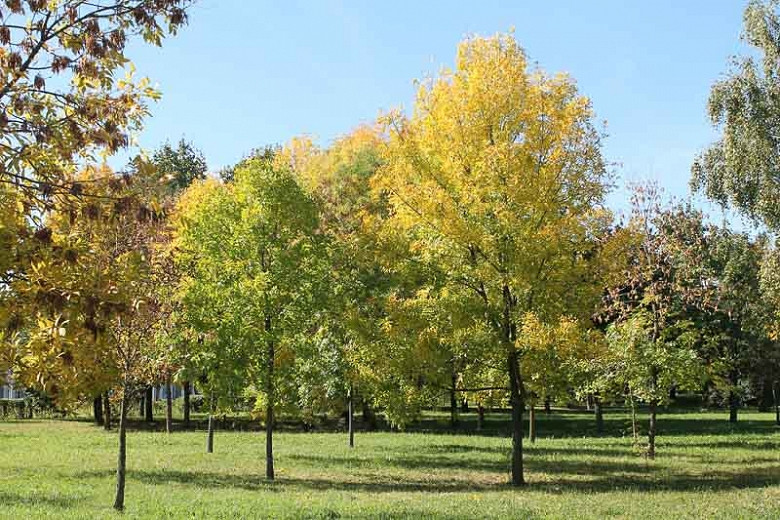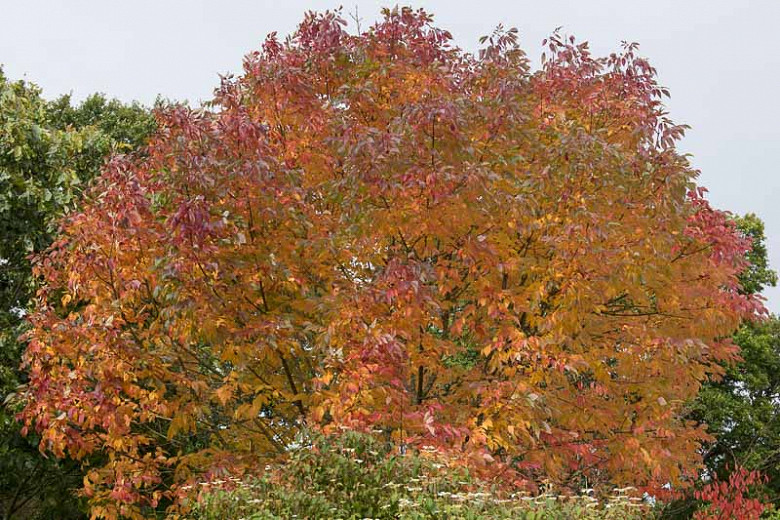Fraxinus pennsylvanica (Green Ash)
Native to North America, Fraxinus pennsylvanica (Green Ash) is a superb, medium-sized, deciduous tree with a straight trunk and a dense crown, pyramidal when young, becoming rounded with age. The foliage of compound pinnate, medium green leaves contains 5-9 leaflets which turn rich shades of golden-yellow in the fall. After dropping to the ground, the attractive silvery-brown bark, ridged and furrowed into diamond-shaped patterns, is revealed, providing winter interest. In mid-late spring, purplish male and female flowers appear on separate trees. The female flowers are followed by drooping clusters of winged samaras, 2 in. long (5 cm), that ripen in fall and may persist on the tree throughout winter. The large seed crops provide food to many kinds of wildlife. Green Ash is most often found in riparian areas, floodplains, and swamps, but is also found in areas that periodically experience drought conditions. Prized for its good form and resistance to insects and disease, Green Ash is a very popular ornamental tree. It makes a splendid shade tree or specimen tree for a large landscape. Tough, the wood of Green Ash is particularly suited for making tool handles, oars, garden furniture and sports equipment.
- Grows up to 50-70 ft. tall (15-21 m) and 35-50 ft. wide (10-15 m).
- A full sun lover, this plant is easily grown in fertile, moist, well-drained soils. It is probably the most adaptable of all the ashes, growing naturally on a range of sites from clay soils subject to frequent flooding and overflow to sandy or silty soils where the amount of available moisture may be limited. Some drought tolerance once established.
- Perfect as a specimen plant.
- This beautiful tree is subject to the emerald ash borer, which can kill the tree within 3-5 years after infestation. This borer now constitutes a serious threat to all species of ash in North America.
- Keep an eye our for lilac borer, carpenter worm, oyster shell scale, leaf miners, fall webworms, ash sawflies and ash leaf curl aphid. Potential disease problems include fungal leaf spots, powdery mildew, rust, anthracnose, cankers and ash yellows.
- Deer resistant.
- Native to North America.
Requirements
| Hardiness | 3 – 9 |
|---|---|
| Heat Zones | 4 – 9 |
| Climate Zones | 1, 1A, 1B, 2, 2A, 2B, 3, 3A, 3B, 4, 5, 6, A2, A3 |
| Plant Type | Trees |
| Plant Family | Fraxinus – Ash Trees |
| Exposure | Full Sun |
| Season of Interest | Spring (Mid,Late)Summer (Early,Mid,Late)Fall |
| Height | 50' – 70' (15m – 21m) |
| Spread | 35' – 50' (10.5m – 15m) |
| Water Needs | Average |
| Maintenance | Average |
| Soil Type | Clay, Loam, Sand |
| Soil pH | Acid, Neutral |
| Soil Drainage | Moist but Well-Drained |
| Characteristics | Showy |
| Native Plants | United States, Midwest, Illinois, Indiana, Iowa, Kansas, Michigan, Minnesota, Missouri, Nebraska, North Dakota, Ohio, South Dakota, Wisconsin, Northeast, Connecticut, Delaware, Maine, Massachusetts, Maryland, New Hampshire, New Jersey, New York, Pennsylvania, Rhode Island, Vermont, Colorado, Utah, Wyoming, Southeast, Alabama, Arkansas, Florida, Georgia, Kentucky, Louisiana, Mississippi, North Carolina, South Carolina, Tennessee, Virginia, West Virginia, Southwest, Oklahoma, Texas |
| Tolerance | Deer, Dry Soil, Wet Soil |
| Attracts | Birds |
| Garden Styles | Prairie and Meadow |
